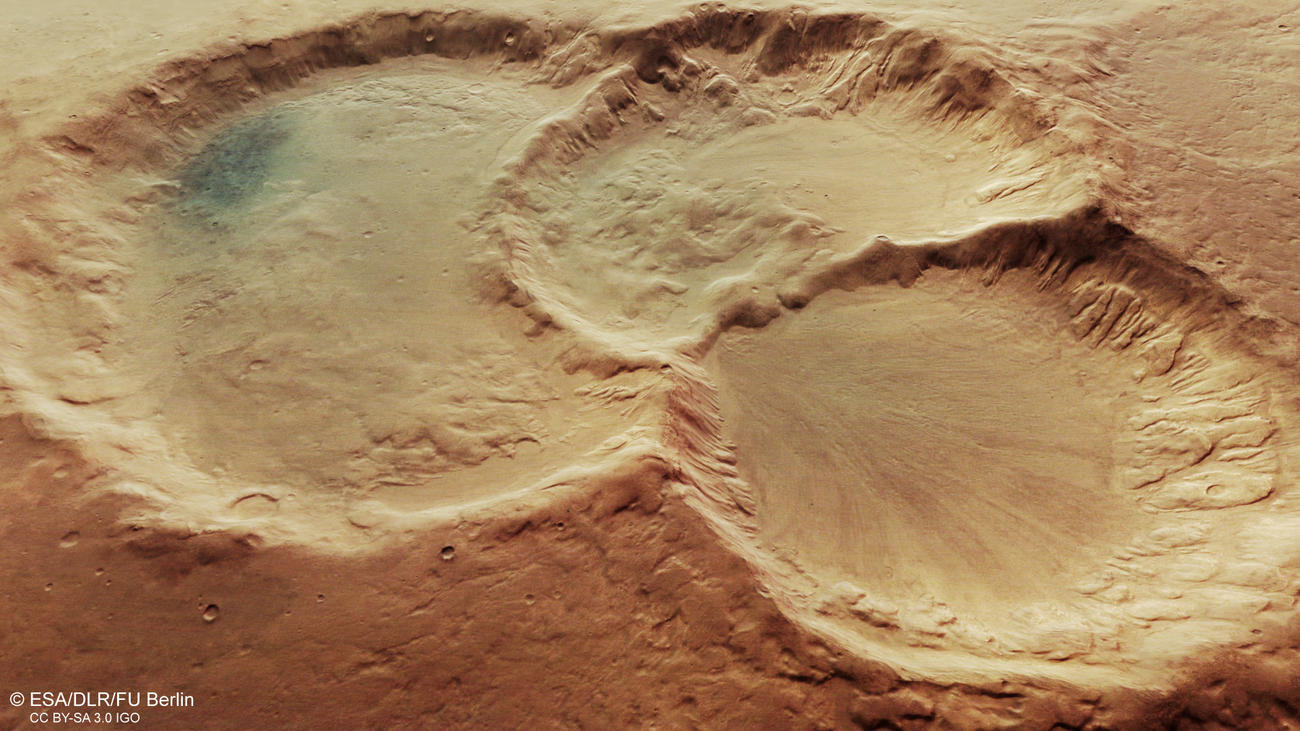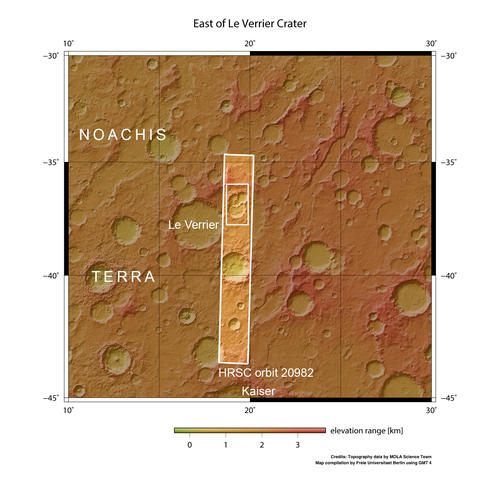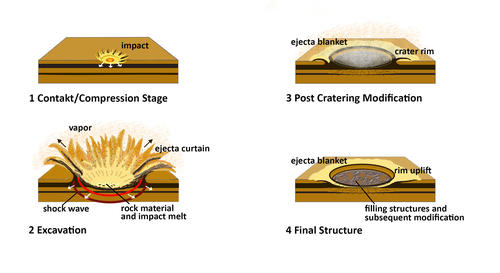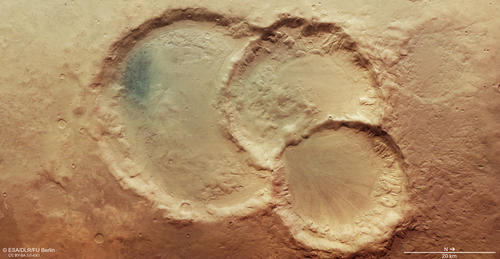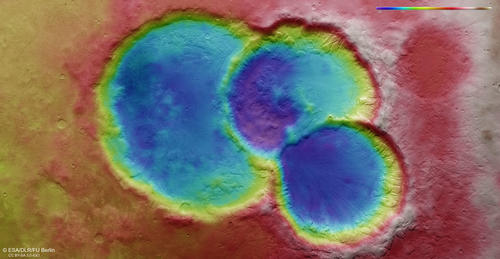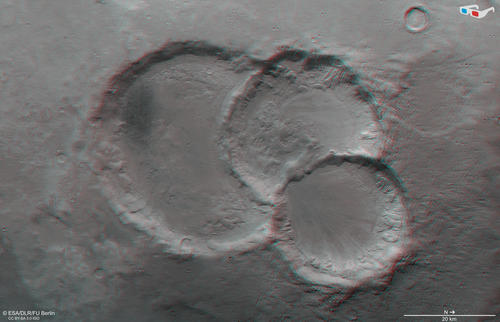Department of Earth Sciences
Service Navigation
Crater Triplets east of Le Verrier on Mars
These images of the High Resolution Stereo Camera (HRSC) on board ESA’s Mars Express mission show a rare triple impact crater in Noachis Terra in the ancient southern highlands of Mars. This region is characterized by strong meteorite and asteroid bombardments about 4.1 to 3.7 billion years ago. The High Resolution Stereo Camera (HRSC) is a camera experiment that was developed and is operated by the German Aerospace Center (Deutsches Zentrum für Luft- und Raumfahrt; DLR).
» read more in the main article and below the gallery about the Crater Triplets east of Le Verrier ...
Crater triplets east of Le Verrier • Location and Scheme
Crater triplets Context map
Image Credit: MOLA Science Team/FU Berlin
Crater triplets east of Le Verrier • Images
Crater triplets HRSC color image
Image Credit: ESA/DLR/FU Berlin
Crater triplets HRSC color-coded terrain model
Image Credit: ESA/DLR/FU Berlin
Crater triplets HRSC anaglyph
Image Credit: ESA/DLR/FU Berlin
Sediments, ice and lots of water
» read more about the Crater Triplets east of Le Verrier on Mars
The highland regions of the southern hemisphere of Mars are covered with impact craters. The craters are much more numerous than in the northern hemisphere, which proves that these regions are among the oldest on the planet. One of these regions is called Noachis Terra and gave its name to the Noachian Period, an epoch that lasted from approximately 4.1 to 3.7 billion years ago and was marked by a strong bombardment by meteorites and asteroids. In this early phase of the planet, large regions were topographically shaped, hence the name Noah, after the ark builder in the Old Testament. The images show three superimposed impact craters. The largest of them measures 45 kilometres across, the middle one approximately 34 and the smallest 28. One scenario for the formation of the craters could be that a meteoroid broke into at least three pieces before all three bodies hit the surface of Mars in succession.
However, it could also be a coincidence that three impactors hit Mars independently at almost the same location over a somewhat longer time interval. Due to the fact that there are still residues of its ejecta blanket around the smallest crater, it is obvious that this smaller crater was formed after the two larger ones. Their ejecta blankets have long since been eroded and blurred. At the northern rim of the crater triplet (top right in the color image, color-coded terrain model, anaglyph) another small, circular structure is visible, possibly representing a fourth, now filled impact crater.
Like many other impact craters in the southern highlands, these three craters show typical rims that have already been smoothed out by erosion, as well as shallow and fairly flat crater floors, indicating that they are filled with sediment. Parts of the crater walls seem to have 'melted' and sunk into the centre of the crater depression, and numerous wide gullies cut through the slopes. Particularly striking are the linear structures in the northernmost crater (lower right in the color image, color-coded terrain model, anaglyph). Its surface morphology resembles that of terrestrial block or debris glaciers, which are common in alpine and polar regions.
This typical flow structure was formed when a mixture of debris and ice from a glacier in the crater flowed downhill to the centre of the crater triplet at a breakthrough in the inner crater rim. The debris traces the movements of the plastic ice flow in the subsurface. This is particularly visible on the colour-coded terrain model. The dark patch in the largest crater represents a small accumulation of dark sands, which form numerous and quite impressive dune fields elsewhere on Mars.
The plain around the impact craters, which also has a smooth, flat surface, shows interesting landscape features. It is not covered by countless small and medium-sized impact craters, as one would expect for a surface of this age on Mars. Secondary craters, which are formed when ejected material hits the area around a newly formed crater, are not visible either. Only a handful of bowl-shaped, lightly eroded and therefore young craters can be found there. It appears that craters older than a certain age have been subject to 'melting' and that many of the smaller and medium-sized impact craters that were even older have disappeared as a result. Ice in the Marian subsurface seems to have played the key role in this levelling process.
Given enough time, smaller surface structures formed on an ice-rich surface may also 'melt' again due to the flow of the ice, breaking down to a certain extent and smoothing the surface again. The process, which is typical of glacial activity on Mars, is referred to as 'terrain softening'. This observation shows that there were once large quantities of water on Mars. They created glacier-like flow structures with very large ice masses, especially during the Noachian Period. Today, most of the glacier ice has long since sublimed and left the debris masses it carried with it as witnesses of its flow processes, similar to glacial moraines on Earth. However, ground ice is still abundant on Mars today. It was first detected in 2008 by NASA’s Phoenix lander in the high latitudes of the northern lowlands.
High Resolution Stereo Camera (HRSC)
» information to image origin and processing
The images were acquired by the HRSC (High Resolution Stereo Camera) on 6 August 2020 during Mars Express Orbit 20982. The ground resolution is approximately 15 meters per pixel and the images are centered at about 19° East and 37° South. The color image was created using data from the nadir channel, the field of view which is aligned perpendicular to the surface of Mars, and the color channels of the HRSC. The oblique perspective view was generated from the digital terrain model, the nadir and color channels of HRSC. The anaglyph, which provides a three-dimensional view of the landscape when viewed using red-green or red-blue glasses, was derived from data acquired by the nadir channel and the stereo channels. The color-coded topographic view is based on a digital terrain model (DTM) of the region, from which the topography of the landscape can be derived. The reference body for the HRSC-DTM is a Mars equipotential surface (Areoid).
HRSC is a camera experiment that was developed and is operated by the German Aerospace Center (Deutsches Zentrum für Luft- und Raumfahrt; DLR).The systematic processing of the camera data took place at the DLR Institute for Planetary Research in Berlin-Adlershof. The working group of Planetary Science and Remote Sensing at Freie Universität Berlin used the data to create the image products shown here.
To download released raw images and DTMs of the region in GIS-ready formats, follow this link to the mapserver.
Images: ESA/DLR/FU Berlin, CC BY-SA 3.0 IGO
Copyright Notice:
Where expressly stated, images are licenced under the Creative Commons Attribution-ShareAlike 3.0 IGO (CC BY-SA 3.0 IGO) licence. The user is allowed to reproduce, distribute, adapt, translate and publicly perform it, without explicit permission, provided that the content is accompanied by an acknowledgement that the source is credited as 'ESA/DLR/FU Berlin', a direct link to the licence text is provided and that it is clearly indicated if changes were made to the original content. Adaptation / translation / derivatives must be distributed under the same licence terms as this publication.
The High Resolution Stereo Camera was developed at the German Aerospace Center (DLR) and built in collaboration with partners in industry (EADS Astrium, Lewicki Microelectronic GmbH and Jena-Optronik GmbH). The science team, which is headed by Principal Investigator (PI) Prof. Dr. Ralf Jaumann, consists of 52 co-investigators from 34 institutions and 11 countries. The camera is operated by the DLR Institute of Planetary Research in Berlin-Adlershof.
